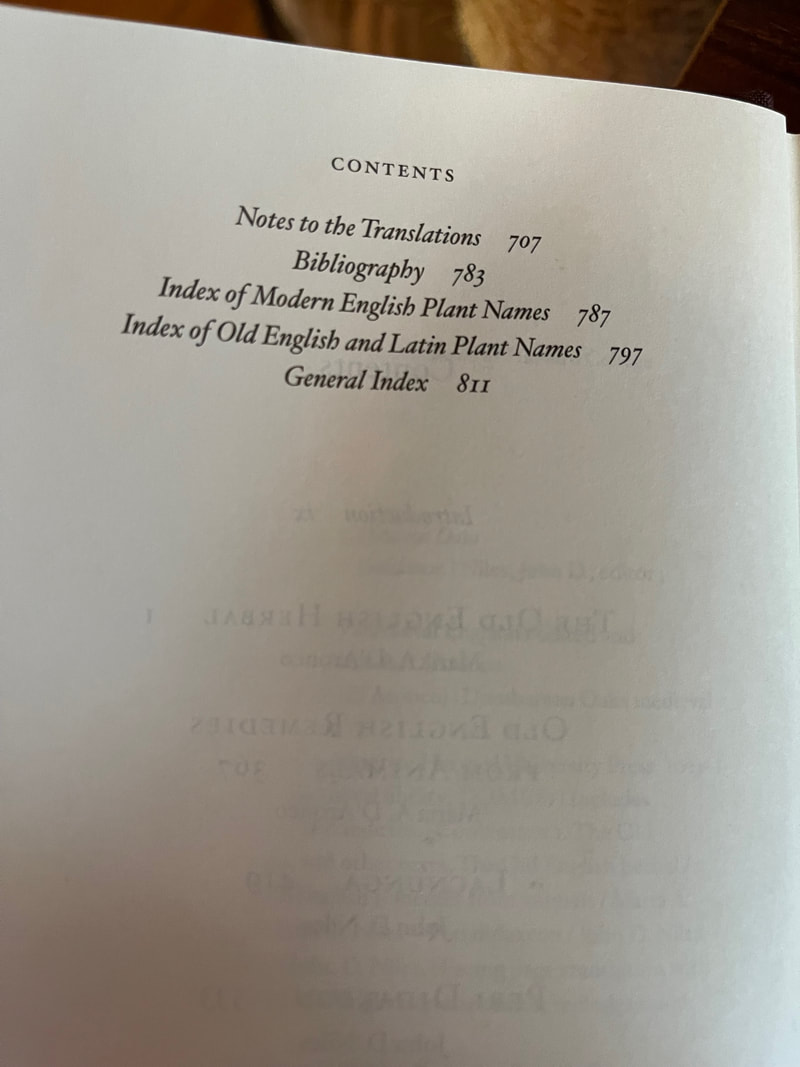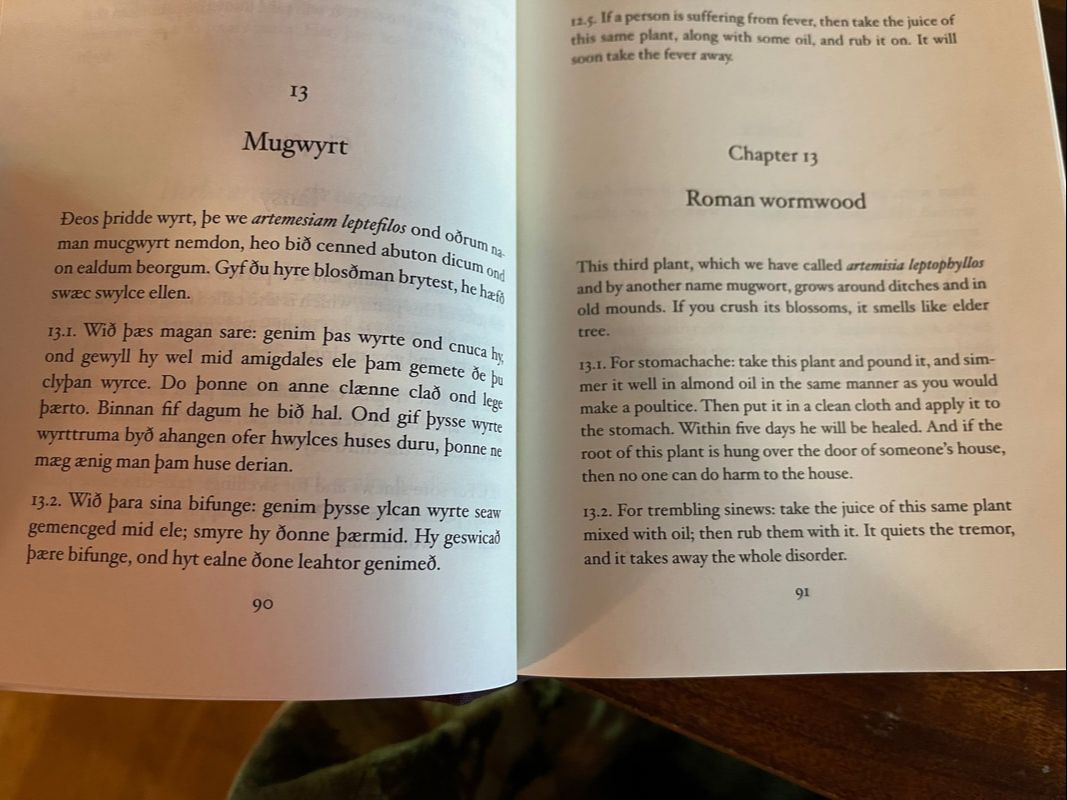|
I have to thank Elska for turning me on to this new release. I am beyond excited to dive into this one.
The book is by John D Niles and Maria A. D'Aronco and I am just delighted. This volume contains the Old English Herbal, Old English Remedies, Lacnunga, Peri Didaxeon and Miscellaneous Remedies. I have the first and third in other volumes, but look forward to comparing the works. I do not have. Peri Didaxeon at all, and the Miscellaneous Remedies come from a wealth of other sources. Each item has the original text and the translation. There is an index of Old English and Latin plant names. Basically, this is going to be SO GOOD and I am very excited about having it! You can purchase the book here: https://amzn.to/3IfPGQf Description from Amazon: Unlike elsewhere in Europe, vernacular writings on health and healing had a major place in early medieval England. These texts―unique local remedies and translations of late antique Latin treatises―offer insights into the history of science and medicine, social history, scribal practices, and culture. Some cures resemble ones still used today; others are linguistically extravagant, prescribing ambitious healing practices. Alongside recipes for everyday ailments such as headaches are unparalleled procedures for preventing infant mortality, restoring lost cattle, warding off elf-shot, or remedying the effects of flying venom. Medical Writings from Early Medieval England presents the first comprehensive edition and translation from Old English of these works in more than 150 years. Volume I includes The Old English Herbal, Remedies from Animals, Lacnunga, the Peri Didaxeon, and a compendium of miscellaneous texts. Table of contents and sample below: |
|
0 Comments
This is the next part of the preparations section from Mirfield's Breviarium Bartholomei, part 13, as found in Popular Medicine in the Thirteenth-Century England, by Tony Hunt. This is my very rudimentary translation from Latin for the section on Oils. Note, despite translation as "essential oils" at the start, these are essential oils as we think of them today. Syrups, electuaries, pills, waters and powders are all covered in previous entries here.
As with the previous translations, headers that are in parentheses are notes from Tony Hunt, while parentheses contained within the copy usually contain my own notes, whether it is clarification of a term or uncertainty of the translation. (Plasters) Of Plasters in General Plaster is called from en, which is 'in', and plasters, 'form', that which is introduced over the form of the disease. Likewise, a plaster is called when many simple substances of different natures, such as powders, gums, fats, are boiled to perfection with wax, sap, and oil, and preserved in magdaleonibus (‘small cylindrical roll of plaster or other medical substance’ also ‘pill or tablet’, from Dictionary of Medical Vocabulary in English, 1375–1550). Afterwards it is stretched over the leather and applied to the place where it is needed, as the diaquilon (‘Plaster containing plant mucilages and juices, herbal oils, litharge, lanoleum, bird lime, gums, beeswax; attributed to Mesue’ Dictionary of Medical Vocabulary in English, 1375–1550) and the apostolicon (‘Apostles’ ointment containing c. 20 ingredients including litharge, colophony, beeswax, herbs, gums; used for wounds, Dictionary of Medical Vocabulary in English, 1375–1550) and many other things. In other words, a plaster is called a hard composition made of different things and put together that can be mixed with the hands. But plaster and poultice are often used for something else. And note that plasters can be kept until they lose their smell. This is the next part of the preparations section from Mirfield's Breviarium Bartholomei, part 13, as found in Popular Medicine in the Thirteenth-Century England, by Tony Hunt. This is my very rudimentary translation from Latin for the section on Ointments. Syrups, electuaries, pills, waters, powders and oils are all covered in previous entries here. As with the previous translations, headers that are in parentheses are notes from Tony Hunt, while parentheses contained within the copy usually contain my own notes, whether it is clarification of a term or uncertainty of the translation. I will greatly be expanding on this section later. Here Mirfield mentions many different ointments and I have been sourcing the recipes for these from various sources to be shared later. One such example is the the Agrippa ointment as described by Culpepper: "Take of Briony roots two pounds, the roots of wild Cucumbers one pound, Squills half a pound, fresh English Orris roots, three ounces, the roots of male Fern, dwarf Elder, water Caltrops, or Aaron, of each two ounces, bruise them all, being fresh, and steep them six or seven days in four pounds of old oil, the whitest, not rank, then boil them and press them out, and in the oil melt fifteen ounces of white Wax, and make it into an ointment according to art. It purges exceedingly, and is good to anoint the bellies of such as have dropsies, and if there be any humour or flegm in any part of the body that you know not how to remove (provided the part be not too tender) you may anoint it with this; but yet be not too busy with it, for I tell you plainly it is not very safe." What recipes such as these really hammers home is the volume of ingredients that go into making of some of these items. The medieval apothecaries were not crafting cures for a single person, but producing (or sourcing) in bulk the items they would need to sell. As I have been harvesting wild plants for my own kit, I have noticed the level of work just to fill one small glass jar with dried, powdered plant matter, and then I consider how much my persona would have had on hand at a time and the level of effort involved (whether from the apothecary, the herb women, or another source) was staggering. (Ointments) On Ointments in General There are some warm and some cold ointments. They are warm, such as dialtea (ointment made from marshmallow root), Agrippa, golden ointment, Arrogon ointment, marciaton (Anglo Normon dictionary lists this as an ointment for the bones/joints; another source mentions that it has wax, fats and 50 other ingredients), brown ointment (ointment for wounds), ointment for salty phlegm, and the like. But they are cold, such as popileon (ointment for wounds or burns of poplar leaves or buds, animal fat and leaves of narcotic plants such as henbane or poppy, the recipes vary, information from Dictionary of Medical Vocabulary in English, 1375–1550, Norri), unguentum citrinum (yellow ointment, possibly involving citrus), unguentum album (white ointment - there are numerous variations of this recipe throughout history, often for removing blemishes, freckles or for sores), and the like. And note that when about powders with oil, etc. if you want to make an ointment, then to one ounce of powder put four ounces of oil, one ounce of wax in summer, an ounce of seeds in winter (“yeme” clarified in the Middle English Dictionary online). But if the ointment receives gums which are dissolved and not worn, the gums should not be counted in the aforesaid measure of weight, since they do not add to the thickness or to the softness. But if the ointment receives the fat of pig, chicken, goose, or other such things which are dissolved into an oily substance, then the dissolved fat must be counted as oil, and you must put the aforementioned amount of powders and wax. (Preparation) Now the method of making ointments from any herbs [if] you choose: first put the herbs in a pot or in a cauldron and let it be filled to the top with water. Then the mouth of the pot should be covered with a strong linen cloth and sealed with clay so that the smoke does not escape, and it should be placed on the fire until the water is consumed. And then let the pot be filled again with water and once again add the chopped herbs before boiling. Then put that herb with the whole decoction in a strong linen cloth and express the juice and use that juice in making ointments. And if you wish to reserve that decoction, make it with wax and reserve it in a box. And note that all of them can be reduced to ointments by medicine, if they are cold, medicine with cold oils, if they are mixed hot with warm oils. And let a little wax be added, and let it bubble a little, and thus the ointment is made. This is how we work with perfumes, and especially hot ones. The ointment is placed in an egg shell and dissolved on the fire. And then, with that ointment, the patient's member should be exposed to the fire or to the sun. And then, after the anointing, some skin or something similar should be placed over the anointed member (membrum can also be member, limb organ or “section”) so that the power of the ointment is preserved.
Typically I fall in love with a material culture (usually clothing) and learn about the garments, build a wardrobe and then start to learn other information to more fulling try to build out a persona. This approach rarely gets me very far into the persona building, but I have a great time with what I do craft and learn.
With my SCA Forestry/14th Century project I made an outfit just to get started, and dove right in on the herbs. Before I go further I am really diving into reading to build a better framework from the ground up. To be fair, this is also much easier to research with an aim towards persona building than anything I have done before. The materials are readily available and mostly in English. This is entirely unheard of for me, and it is rather refreshing. You can view most of my library for this subject matter HERE, though I still do have a few more books to add. Below I am going to review two of the items that read this past month that immensely helped me set the stage for the work I plan to keep doing.
I have three books I am tackling next. Two are based on the works of the ancient physician Galen (129-216BCE), as this knowledge was still studied and in use in the Middle Ages. The first is The Alphabet of Galen and the other is Galen: SelectedWorks. The other book that is currently sitting next to me, just waiting to be picked up is Popular Medicine in the Thirteenth Century England by Tony Hunt. I hope to review these as I read them as well.
A Wandering Elf participates in the Amazon Associates program and a small commission is earned on qualifying purchases. This commission allows the purchase of more books! |
SCA ForestryThis page is dedicated to my project and research related to SCA Forestry Guild activities and my expanding medieval apothecary. Here I will build out a 14th Century English men's kit and have some adventures in the woodlands! Archives
September 2023
A Wandering Elf participates in the Amazon Associates program and a small commission is earned on qualifying purchases. This commission becomes more books! Categories
All
|




 RSS Feed
RSS Feed